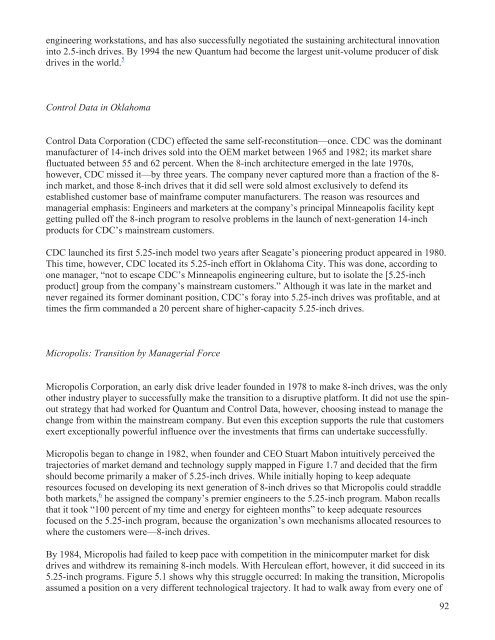PRUEBAS
PRUEBAS
PRUEBAS
Create successful ePaper yourself
Turn your PDF publications into a flip-book with our unique Google optimized e-Paper software.
engineering workstations, and has also successfully negotiated the sustaining architectural innovationinto 2.5-inch drives. By 1994 the new Quantum had become the largest unit-volume producer of diskdrives in the world. 5Control Data in OklahomaControl Data Corporation (CDC) effected the same self-reconstitution—once. CDC was the dominantmanufacturer of 14-inch drives sold into the OEM market between 1965 and 1982; its market sharefluctuated between 55 and 62 percent. When the 8-inch architecture emerged in the late 1970s,however, CDC missed it—by three years. The company never captured more than a fraction of the 8-inch market, and those 8-inch drives that it did sell were sold almost exclusively to defend itsestablished customer base of mainframe computer manufacturers. The reason was resources andmanagerial emphasis: Engineers and marketers at the company’s principal Minneapolis facility keptgetting pulled off the 8-inch program to resolve problems in the launch of next-generation 14-inchproducts for CDC’s mainstream customers.CDC launched its first 5.25-inch model two years after Seagate’s pioneering product appeared in 1980.This time, however, CDC located its 5.25-inch effort in Oklahoma City. This was done, according toone manager, “not to escape CDC’s Minneapolis engineering culture, but to isolate the [5.25-inchproduct] group from the company’s mainstream customers.” Although it was late in the market andnever regained its former dominant position, CDC’s foray into 5.25-inch drives was profitable, and attimes the firm commanded a 20 percent share of higher-capacity 5.25-inch drives.Micropolis: Transition by Managerial ForceMicropolis Corporation, an early disk drive leader founded in 1978 to make 8-inch drives, was the onlyother industry player to successfully make the transition to a disruptive platform. It did not use the spinoutstrategy that had worked for Quantum and Control Data, however, choosing instead to manage thechange from within the mainstream company. But even this exception supports the rule that customersexert exceptionally powerful influence over the investments that firms can undertake successfully.Micropolis began to change in 1982, when founder and CEO Stuart Mabon intuitively perceived thetrajectories of market demand and technology supply mapped in Figure 1.7 and decided that the firmshould become primarily a maker of 5.25-inch drives. While initially hoping to keep adequateresources focused on developing its next generation of 8-inch drives so that Micropolis could straddleboth markets, 6 he assigned the company’s premier engineers to the 5.25-inch program. Mabon recallsthat it took “100 percent of my time and energy for eighteen months” to keep adequate resourcesfocused on the 5.25-inch program, because the organization’s own mechanisms allocated resources towhere the customers were—8-inch drives.By 1984, Micropolis had failed to keep pace with competition in the minicomputer market for diskdrives and withdrew its remaining 8-inch models. With Herculean effort, however, it did succeed in its5.25-inch programs. Figure 5.1 shows why this struggle occurred: In making the transition, Micropolisassumed a position on a very different technological trajectory. It had to walk away from every one of92


